Giant has released an update to its compatibility list for its range of Giant and Cadex wheels with hookless rims, as featured on its high-end performance road bikes, such as the 2021 TCR Advanced SL and TCR Advanced Pro.
Details of the safety testing protocol used are also included, as is a list of tyres that have explicitly failed Giant’s testing, and thus should not be used on Giant or Cadex hookless rims under any circumstances.
Hookless rims for road use are a relatively new bit of tech, but as we’ve discussed before, it’s not without its teething problems – largely surrounding tyre compatibility.
Hookless rims and tyre compatibility
A lack of traditional bead hooks means hookless rims are generally only compatible with tubeless or tubeless-ready tyres because standard clincher tyres require the bead hooks to stay seated on the rim when inflated.
The reality is far murkier however, with wheel brands discovering that not all currently available tubeless tyres are safe to use on hookless rims either, especially at the higher pressures used for road cycling.
This has led to some manufacturers mandating relatively low maximum inflation pressures for wheels with hookless rims, or simply producing lists of tyres known to be compatible with their wheels, in order to prevent consumers experiencing potentially dangerous tyre blow-offs.
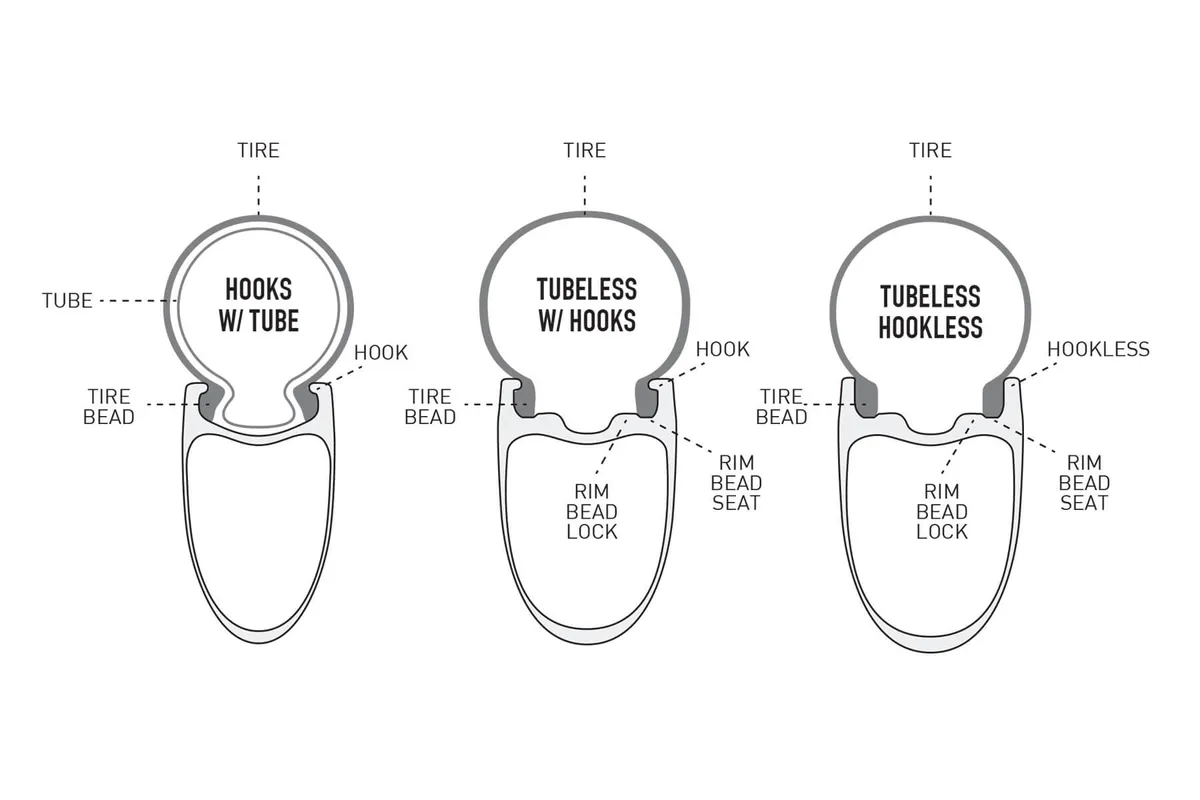
A mixed bag
The list of compatible tyres and sizes sees three road tyres and two gravel tyres added, bringing the total number of approved tyres to fourteen.
- Cadex Classics Tubeless: 700 x 25c / 700 x 28c / 700 x 32c
- Schwalbe Pro One TLE: 700 x 25c / 700 x 28c / 700 x 30c
- Maxxis High Road: 700 x 25c / 700 x 28c
- Maxxis All Terrane: 700 x 33c
- Maxxis Velocita AR tyres: 700 x 40c
However, it should be noted that these tyres are only approved in the specifically listed models and sizes (Schwalbe’s new Pro One TT tyre is not yet approved, for example), so consumers will need to ensure they study Giant’s ‘What tyres can I use?’ chart carefully.
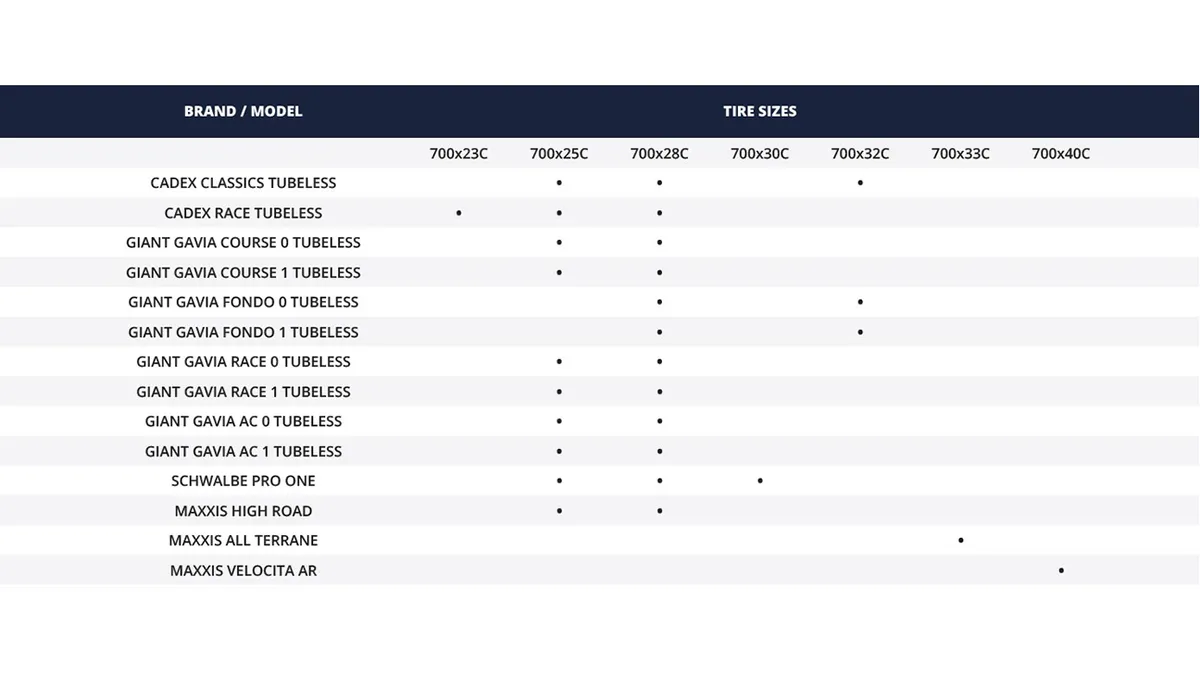
There’s some good news specifically for gravel riders, though.
Giant says that if a tyre has a maximum pressure (as indicated on the tyre sidewall) below 72.5psi (5 bar) – which would generally be larger volume tyres designed for gravel and off-road use – and the tyre is tubeless compatible according to the tyre manufacturer, then it can be used on Giant and Cadex hookless wheels, even if it does not appear on Giant’s ‘What tyres can I use?’ chart.
The news for road cyclists is less rosy, however.
Use of tyres with a maximum inflation pressure (as indicated on the tyre sidewall) above 72.5psi (5 bar) – generally all road-specific tyres – that do not appear on the chart, is done at your own risk, because Giant cannot guarantee their safety.
The following road tyres also failed Giant’s test protocol and “do not function properly” with Giant or Cadex hookless rims:
- Vittoria’s Rubino Pro TLR: 700 x 25c
- Vittoria Corsa TLR: 700 x 25c
- Continental GP5000 TL: 700 x 25c
- Pirelli Cinturato: 700 x 24c / 700x26c
Giant notes it is working with brands of tyres that have failed, so that updates can be made to their construction to ensure compatibility “as soon as possible”, but no specific timeline is given.
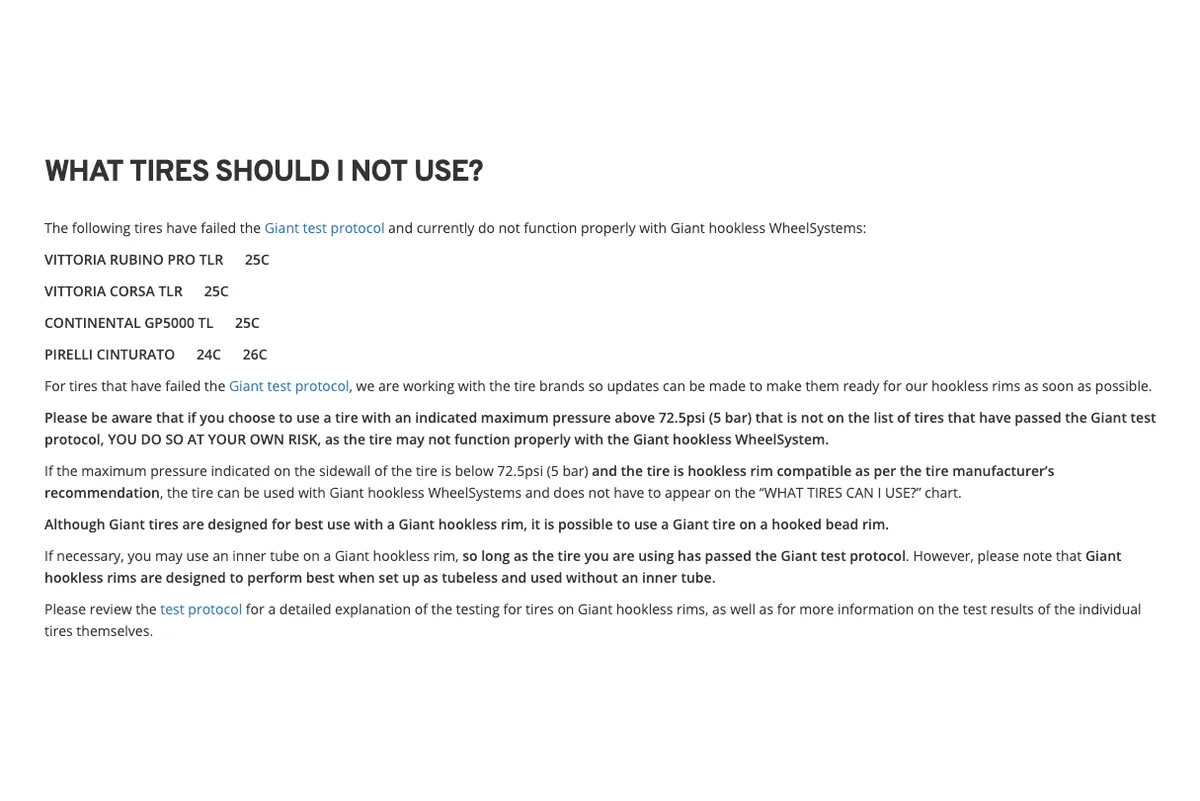
Giant’s testing protocol
Giant’s tyre testing protocol consists of two different pressure tests.
In the first test – the high pressure tolerance test – the tyre is inflated to a series of ever increasing pressures, and must withstand blowing off the rim at each pressure for 24 hours.
The first pressure is 72.5psi (5 bar), which is then followed by the tyre's stated maximum inflation pressure. The tyre is then inflated to 1.2x and 1.5x its stated maximum inflation pressure (again, having to withstand a 24-hour interval without blowing off between each increase).
Giant says these extreme high pressures simulate situations such as hitting a square edge or pothole at high speed, which could cause tyre pressure to suddenly increase.
The second test – the high pressure braking test – involves the tyre being inflated to 1.2x its stated maximum pressure on a disc brake wheel. It must then be able to withstand braking forces without blowing off or experiencing a shift in position of more than 3mm.
This second test seeks to replicate excessive friction between the road and the tyre, caused by “uncontrolled braking” at high speeds, which can potentially lead to a blow-off.
If a tyre passes both of these tests, then it is approved for use on Giant and Cadex hookless rims, in the tested model and size.
The full report, including full details of those tyres that have passed and failed the test, is available on Giant’s website.
As always, we’ll congratulate Giant for being open and honest about its testing protocol.
Experiencing a wheel or tyre failure while riding can be extremely dangerous, and it’s good for consumers to see the efforts Giant make to protect their safety alongside the introduction of this new technology.
Why is compatibility so limited?
Proponents of hookless rims, such as Giant, claim they offer a number of distinct advantages over traditional hooked rims, including improved rim durability, aerodynamics and handling.
Zipp has also said hookless rims are cheaper and easier to manufacture, and produce less waste product, meaning they’re potentially better for the environment too.
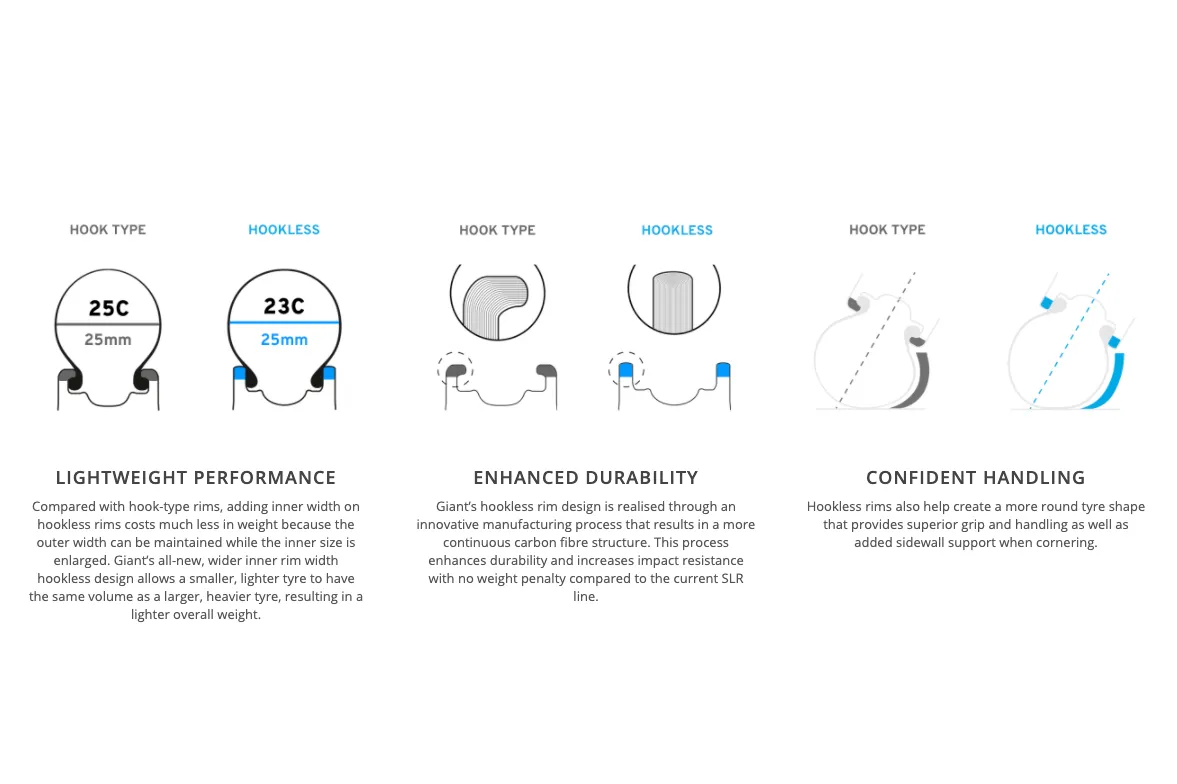
But with wheel manufacturers and tyre brands mostly working separately, and without a clear road tubeless standard, we’ve seen a number of different approaches to this issue.
Almost all hookless rim manufacturers completely rule out compatibility with standard clincher tyres (Corima being the only exception we’re currently aware of), but that’s where the simplicity ends.
Zipp, for example, simply says its hookless rims (like those found on the latest 303 Firecrest and 303 S wheelsets) “are compatible with all tubeless or tubeless-ready tyres on the market (up to a maximum inflation pressure of 72.5psi), except those where the tyre manufacturer specifically prohibits the use of hookless rims.”
In contrast, Enve has produced detailed compatibility charts for its range of hookless rims.
For its part, Giant claims its safety testing protocol (detailed above) is one of the most stringent in the industry and that this is the reason for such limited compatibility.
David Ward, product and training manager at Giant, told BikeRadar: “We appear to be the only wheel brand being proactive with tyre brands to collate an approved list which all parties are happy with.
“The approved list will continue to grow over the next few months too, as more brands see the benefits of Giant’s hookless technology and come on board.”
He also added that Giant feels both hookless rims and tubeless technology will be the default for road wheels “in the not too distant future”, and that Giant’s performance road tyre range provides consumers with a choice of tyre types and sizes (although rolling resistance nerds might be disappointed at a lack of publicly available data for its high-end options).
However, it’s hard to escape that – as things stand – Giant and Cadex hookless wheels appear to have the smallest number of compatible tyres of any performance bicycle wheels currently on the market.
Some may be reassured that Giant insists this is only a temporary issue but, as mentioned, there isn’t a clear timeline for when these compatibility issues will be resolved.
Likewise, questions linger about whether consumer and vendor awareness of these issues is sufficient enough to prevent the use of incompatible (and potentially dangerous) rim and tyre combinations.
Giant says its hookless rims do come with warning stickers that read, ‘only use tires supplied or approved by Giant for the best and reliable performance of your WheelSystem’, but the user manual included with a 2021 Giant TCR Advanced Pro Disc 2 (Giant bicycle owner's manual, version 11.0) doesn’t include any information on this situation.
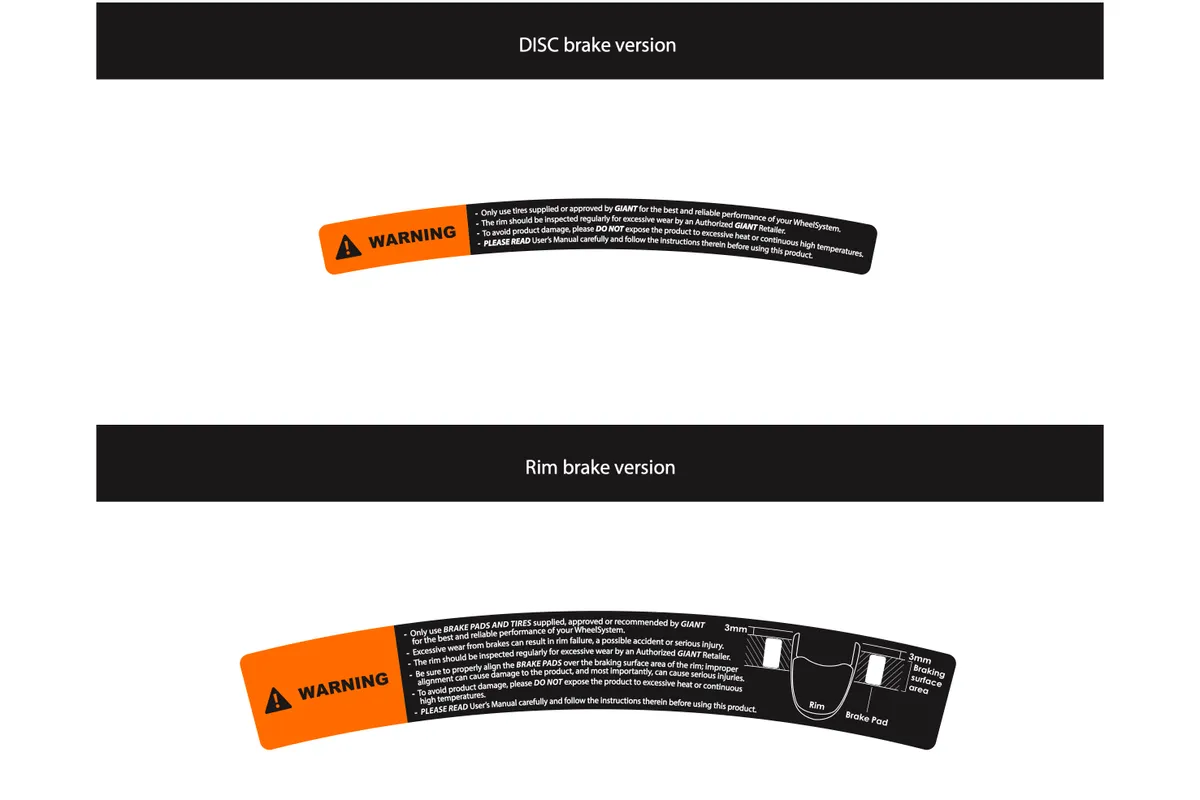
As Giant releases more information about tyres it has tested on its hookless rims, we’ll update this article.
